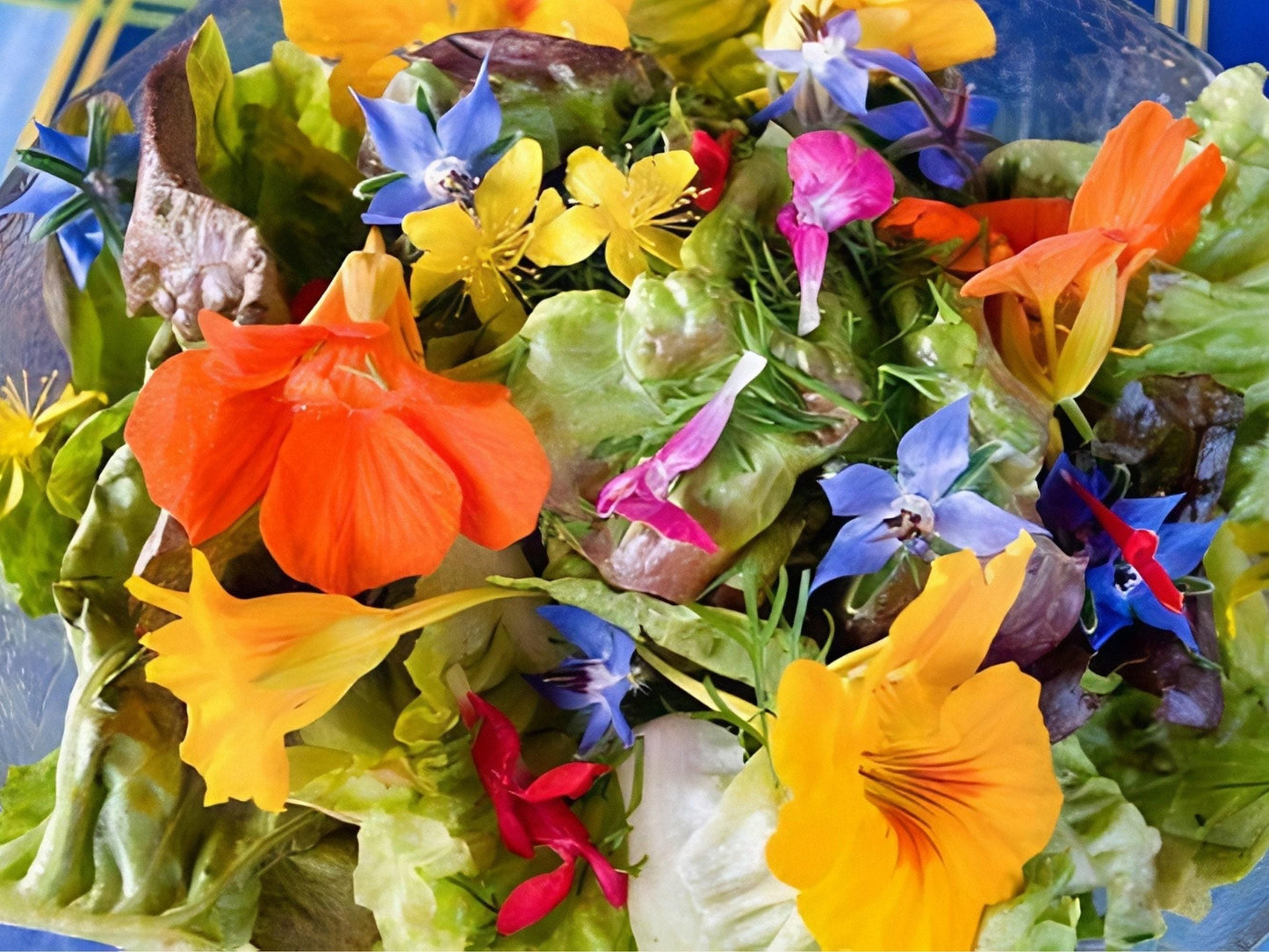Borage (Borago officinalis) is a beautiful heirloom herb, admired for its brilliant blue, star-shaped blossoms and lush, textured foliage. It’s an excellent choice for gardeners of all levels, whether you're just starting or have years of experience. Thriving in sunny, well-drained spots, Borage is a versatile addition to herb gardens and pollinator-friendly spaces. Loved by bees and other beneficial insects, Borage supports a thriving garden ecosystem. It also reseeds itself, ensuring that it returns year after year to bring continuous beauty and utility to your garden. Its edible flowers and leaves are popular for adding a mild cucumber flavor to salads and beverages, and the flowers can be candied for decorative treats.
SCROLL DOWN FOR DETAILED GROWING INFO
All Nimble NiteCap Seeds are:
- Heirloom
- Organic
- Non-GMO
- Open Pollinated
- Untreated
- US Grown
- Growing instructions included
- Regular testing is conducted to uphold the highest germination standards, all the while employing appropriate seed storage techniques.
Sustainable Packaging & Shipping:
- NimbleNitecap seeds are packed in eco-friendly, compostable seed packets. Seed packets are printed in-house with vegetable-based inks on biodegradable, recycled materials. (Small plastic bags are infrequently used to prevent the loss of very small seeds.)
- All orders are carefully packed and shipped with tracking via USPS First Class (or Priority, if selected) in padded ECOENCLOSE recycled and reusable mailers, or recycled boxes to protect your items in transit.
- Most orders ship out the same or next business day! Please note that this time may be extended during peak season.
- FREE SHIPPING on all orders of $35 or more. Flat Rate shipping no matter how many packets you order.
Common Names: Borage, Starflower
Latin Name: Borago officinalis
Type: Herb
Life Cycle: Annual
USDA Zones: 2 - 10
Stratification: Not Required
Germination Ease: Easy
Sunlight: Full Sun
Moisture: Moderate to Low
Soil: Well-drained, sandy or loamy soils
Height: 18-36 inches
Spread: 12-24 inches
Color: Bright blue flowers, green foliage
Bloom Season: Late Spring through Fall
Companion Plants: Tomatoes, Strawberries, Squash (Borage repels pests like tomato hornworms and improves the flavor of tomatoes while attracting pollinators.)
Climate Adaptability: Thrives in temperate and warm climates, drought-tolerant once established
~ Sowing ~
When to Sow Outside:
Direct sow in early spring after the last frost, or in fall in warmer climates for earlier blooms.
When to Start Inside:
Not recommended; Borage prefers direct sowing.
Days to Emerge:
5-10 days
Seed Depth:
Plant seeds 1/4 to 1/2 inch deep.
Seed Spacing:
Space seeds 12 inches apart.
Hardiness:
Frost-tolerant once established, but young seedlings should be protected from heavy frost.
~ Growing ~
Soil:
Borage thrives in well-drained, sandy or loamy soils but can tolerate poor soil conditions. For best growth, enrich the soil with organic matter.
Watering:
Keep soil moderately moist, especially during germination. Once established, Borage is drought-tolerant and requires little watering.
Light and Temperature:
Requires full sun for optimal growth and is heat and drought-tolerant once mature. It grows best in temperatures between 60°F and 85°F.
Maintenance:
Borage is low-maintenance. It reseeds readily, so remove unwanted plants if necessary. Deadhead spent blooms to prolong the flowering season.
Container Friendly:
Borage can be grown in containers, but the pot must be deep to accommodate its long taproot. Ensure adequate drainage.
~ Harvesting ~
When to Harvest:
Harvest young leaves when tender, and harvest flowers as they open for fresh use or decoration.
How to Harvest:
Snip leaves and flowers off at the base with scissors. Harvest regularly for continuous production.
Drying and Storing:
Flowers and leaves can be air-dried. Store dried parts in an airtight container in a cool, dark place.
Edible Use:
Both the leaves and flowers are edible. The leaves add a mild cucumber flavor to salads, while the flowers can be used fresh or candied for desserts.
~ Seed Saving ~
Seed Collection:
Allow seed heads to dry on the plant. Once dry, collect the seeds for future use.
Seed Cleaning:
Remove seeds from the dried flower heads and allow them to air dry completely before storing.
Seed Storage:
Store seeds in a cool, dry place. Seeds remain viable for 1-2 years if properly stored.
~ Additional Information ~
Forage for Pollinators:
Borage is a magnet for bees and other pollinators, making it an excellent addition to eco-friendly gardens.
Origin:
Native to the Mediterranean region, Borage has been cultivated for centuries for its medicinal and culinary uses.
Nomenclature:
Borago officinalis is the Latin name for Borage. The name "Borage" comes from the Latin "borra," meaning "hair," referencing the plant’s bristly leaves.
History:
Historically, Borage was believed to bring comfort and courage. It has been used in herbal medicine and to flavor drinks, including the traditional Pimms Cup in England.
Climate Adaptability:
Borage adapts well to a variety of climates, from temperate to warmer regions. It is drought-tolerant and thrives in dry, sunny conditions once established.



















